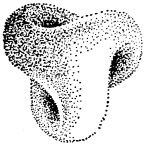
Three Characteristic Features of Water
Three characteristic features of water, forming together a complete picture, emerge from our considerations. Two of these are clear for all to see, the third is almost unknown, requiring very sensitive methods of observation. The first is the activity of water in all metabolic processes in the great organism of the earth and in each separate living creature. The second is its close connection with all rhythmical processes in time and space. The third comes to light in our observation of the sensitivity of boundary surfaces, indicating that water is a cosmic sense organ of the earth. All three functions— functions which are well known to us in the world of living organisms—form a whole.
Is it not as though water were itself an organism? Do we not see in water the threefold organism of man—an archetypal picture, though purely functional, of the metabolic, nerve-sense and rhythmic organizations?1 Perhaps these three characteristics of water form the basis of all living organisms, whose specialization goes in the direction of one or other of the three? Let us now consider the three characteristics in the light of this new question, commencing with water as a ‘substance’.
As all organisms consist chiefly of water, it is obvious that water is the primary and most essential element for all living processes. It refrains from taking on a form of its own, but fills out any form offered it and envelops any that dip into it. In their development many creatures, including man, climb out, as it were, from the water on to dry land. The human embryo, enveloped in the maternal organism and entirely floating in water, gradually creates the distinct form of its organs out of the liquid. In the second month it still consists almost entirely of water, and even in old age about 60 per cent of the human body is water. The first and very often the last food taken by a human being is liquid. It is only because water flows and dissolves substances that organisms—plant, animal and man— can take solid substance as nourishment at all. The whole process of breaking down and building up of substances within an organism is unthinkable without water; by far the greater proportion of chemical changes is dependent on water as a mediating and dissolving element. In its own nature, water does not commit itself in any way; chemically it is neutral and therefore has a multitude of possibilities for nearly all chemical changes.1
In metabolism, however, it is not merely a question of transformation of substances, but also of the accompanying heat processes; for these too, water is the basis. It is able to absorb not only large quantities of dissolved substances but also a great amount of heat and to transport it wherever it goes. The countries of northern Europe owe their mild climate to this fact; the Gulf Stream flowing past them brings the warmth of the tropics with which it is laden. It flows on into polar regions, where eventually, much cooled, it densifies and sinks to the bottom, still flowing on further and beginning a circulation that fills the Atlantic Ocean to the depths, causing a great process of oceanic ‘metabolism’. (There are similar processes in the Pacific.) Ocean currents of this kind play an important part in the fluctuating temperatures of the planet; they belong to the great regulatory systems of the climates, on which the life of the earth depends, and which are adjusted to fractions of a degree Centigrade, e.g. in the average annual temperature. Thus our attention is drawn to the ability of water to absorb large quantities of heat. This also plays an important part in the blood of the human being.
A gram of water absorbs eighty calories when it changes from ice to water of a temperature of 0°C, and each further increase of a degree in temperature means taking in a further calory per gram of water. This is of course approximate; a more detailed observation shows that the amount of heat needed to increase the temperature by one degree is not the same over the whole range of the thermometer, and that a minimum amount is needed around 37° C. At this temperature—which is the temperature of human blood—water is most easily warmed. May we not look here for a relationship with man? Does not water reflect, as though in anticipation, the laws of the human warmth organism? In any case the unique properties of water in connection with heat are fundamental to the human organism. We may indeed discuss all the questions concerning water’s relation to heat not only from the aspect of water, but also from the point of view of the human being.
Whichever material qualities of water we study, they all point to the world of living organisms with their metabolic processes as well as to the human organism and far beyond it.
The third of the above mentioned qualities of water, its sensitivity, is the opposite of the metabolic process. Even as a substance, in the liquid state, it is in the nature of water to be sensitive to the smallest stimuli, which results in effects that can be clearly observed. A slight rise in temperature, for instance, will at once considerably change its fluidity. Its fluidity, the state of being easily displaced, is at every moment an expression of the temperature in its surroundings. Just as honey flows more easily in the warm, so does water when it is warmed; sun-lit water is less dense and forms vortices more easily than that of a shady forest stream. When it leaves the dark spring or the cool woods it adjusts even in its inmost ‘structure’ to the new conditions. It opens itself like a sense organ to outer influences. In face of the light it becomes, through its qualities of reflection and transparency, like an eye for the whole earth.
In surface tension, through which water strives to attain a spherical, drop form, it again shows great sensitivity towards the influences of its surroundings. The merest traces of substances added to water suffice to cause a quick and considerable change in its surface tension. The surface tension of water that has stood for a few moments is considerably different from that of freshly drawn water. In the same way it reacts sensitively to the most minute changes in temperature. The surface tension of a jet of liquid issuing from a thin pipe is just like an instrument, played upon above all by the rhythmical processes of the surroundings. For instance a jet of liquid issuing from an opening disintegrates in the rhythm of approaching sound waves into separate drops; or it reacts in a corresponding manner to the most minute changes in the surrounding electrical conditions. Water’s ‘sensitivity’ is as great as that of the human ear. A gentle breeze blowing over the surface of water immediately creases the surface into the tiniest capillary waves, but also any small rod drawn through water, or obstructing flowing water, immediately causes it to react with a whole system of surface tension waves (Plate 6). Water may be even more ‘impressed’ by a stone thrown into it, and it passes this impression on rhythmically to its whole mass. The great rhythms of the tides are a response to forces that work in the interplay of earth and cosmos ... and for which, through its great impressionability, the element of water is a receptive ‘sense organ’.
As we have shown in the experiments already described, the inner surfaces permeating the whole mass of flowing water act like sensory membranes by which the water is susceptible to delicate influences from the distant surroundings of the earth.
The boundary surfaces arising in the interplay of different streams resemble such membranes, responding immediately with expansion or contraction to the most delicate changes in the forces causing them. We described them as sensitive forms of balance, on which it is possible for the most delicate influences to play. Isaachsen describes these boundary surfaces, arising from the interplay of different forces, as ‘feelers’, comparing them to instruments with the sensitivity of sense organs, and Novalis calls the element of water simply the ‘sensitive chaos’.
Every activity of water takes place rhythmically; this is the second of the characteristics mentioned above. Every influence on the surface of a stretch of water immediately calls forth a rhythmical series of waves; every twig dangling in a river causes a train of vortices in rhythmical sequence; about every surface of contact between two streams there is a rhythmical play of waves and vortices. The interplay of earth, moon and sun finds its immediately visible expression in the rhythmical waves of the tides. A rhythm as great as that of the advancing and receding tides can become the bearer of countless smaller rhythms, for instance of the waves caused by the wind, hurrying across its surface. But there must always be an interplay between at least two forces in order to create a balancing rhythm between them. Water is the element that brings about a state of balance everywhere. Even within itself it maintains a harmony between its qualities as an earthly substance and its cosmic aspect of sensitivity. Rhythm is simply its ‘life element’, and the more it can be active rhythmically the more it remains alive in its inmost nature. Where it is deprived of rhythm and can no longer flow freely in meanders, or trickle over stones and murmur and chatter and form waves, it begins gradually to grow weary and die. Then it loses its ability to mediate between heaven and earth.
In the living kingdoms of nature water is the bearer of the rhythmical processes—in the rise and fall of the sap in plants and in the pulsation of the bodily fluids in man and animal. Here too, it maintains within itself the manifold rhythms of the earth-organism and the universe, passing them on to the creatures of the earth.
It is in the nature of water that it possesses those characteristics fundamental to all organisms for the maintenance of their life; yet all is purely functional and without fixed form. These living qualities are nevertheless so clearly present and so evidently at work that the picture of the human organism is conjured up before us in its threefold nature—metabolic, nerve-sense and rhythmic organizations— revealing in harmony the basic characteristics of all living organisms. What in water is still entirely intermingled and united, is in man and animal specialized out into three processes, appearing as particular organic functions and even solidified and condensed into the respective organic forms. In the following chapters we shall study three such organs: the ear, a sense organ; the intestine, an organ of metabolism; and the heart as the centre of the rhythmical organization of the human being. They remind us of the three characteristics of water; or vice versa, water can remind us of the three organic systems of the human being.
The Ear
The sense organ with which we can can perceive something of the inner nature of things, the ear, itself retreats from our observation deep into an interior space of its own. An extremely delicate structure, it lies, surrounded and filled with fluid, in a cave of the hardest ‘rock’, like the spiral shell of a snail that has secreted hard substance around itself as a protection. Together with the neighbouring semicircular canals, this organ is one of the most sensitive in our whole organism. A glance at the external ear sees the spiral form winding its way into the inner ear and becoming lost there. Like a vortex with its funnel, the auricle and the ear passage lead to the first membrane, the ear-drum, against which the ossicles of the middle ear lean. Like a minute ‘system of limbs’ (R. Steiner), they pass on the rhythms they receive to the membrane of the fenestra ovalis in the inner ear, where they are taken still deeper into the dark regions of the cochlea. The passage into the cavity of the inner ear is like a journey through the elements, from air via the solid medium to the liquid, and every form on the way reveals its origin in the archetypal movements of fluids.
This can be seen especially in the organ closely related to the cochlea—the semicircular canals. These also develop out of the first vesicle of the ear. In three small curved canals, set at right angles to one another, there is a liquid, and every movement of the head causes this liquid to move along the walls of the canals. Sensory hair cells protruding into the liquid take up the stimulus of the movement and inform us as to our movement and position in space. The organ is based on rotating movements of liquid in a closed circulation. Some lower animals, for instance the river lamprey, have only one of these canals; instead of the other two they have cavities in which a liquid, actively agitated by cilia, is driven round in vortices. The semicircular canal that appears at a later stage in the evolution of animals is here still only in the realm of function and movement, thus revealing the basic principle of formation. A structure intersecting itself three times, and as though emerging out of vortical movement, is built into human beings, giving them the capacity to hold themselves erect, to move and to experience themselves in space. In the semicircular canals we have an image of the surface returning into itself with which projective geometry deals, (pictured in Boy’s model of the plane at infinity).

Geometrical form after Boy’s model of the plane at infinity
The membranous cochlea of the inner ear, a tube filled and surrounded with fluid and having a blind extremity, combines the spiralling surface—an archetypal form of flowing movement—with the spiral twisting of a vortex. The vortex, which otherwise appears in a liquid, is here moulded into a perfect, most delicately differentiated sense organ. The formative principle of the curling, rolled-in surface of contact between different regions of liquid is present throughout the ear. It is as though in the embryonic development of the human ear the sacculus were drawn with a force of mighty suction into a liquid vortex, its surface rolled up to form the sensitive boundary membrane and at the same time twisted through 90 degrees.
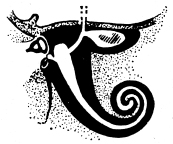
The cochlea of the human ear (after de Burlet); the semi-circular canals are omitted
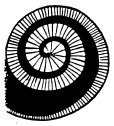
In the cochlea, the basilar membrane spirals up to the apex, growing wider towards the top
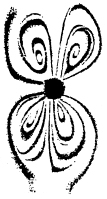
An object moved backwards and forwards in water creates a field of vortices
Thus in the inner ear the two scalae are like the two regions of liquid, on either side of a boundary layer; they hold the really sensitive organ between them and develop it further. It must be realized that in the phylogenetic development of the organ of hearing there is no actual occurrence of rotating liquids—apart from what we have already described regarding the vortex cavities in the labyrinth of the river lamprey. It is rather as though the rotating principle as a force were invisibly to permeate and guide the embryonic involution. A time-lapse photograph of the development of the cochlea would certainly reveal a movement like that of a vortex in a liquid. Vortices with a distinct spiral twist may also arise when rhythmical impulses influence a fluid at rest, for instance the movement to and fro of an object on the surface of water. A system of adjacent vortices—for example, four lying side by side—results from movements of this kind.
Taking into account that in the process of hearing incessant rhythmical impulses reach the fenestra ovalis—a delicate membrane leading to the fluid in the inner ear—from outside one can understand how this vortex-like organ might develop out of the world of rhythmical sounds; it was formed by sound for sound (as Goethe might have put it). Indeed, the lengthening and curling in of the ductus endolymphaticus, filled with fluid, did not occur in animal evolution until they left the element of water and stepped on to dry land; the rhythmical sounds in the atmosphere began to vibrate into their watery world. In crocodiles and birds the cochlea formation began to develop in the ear. One might think of writing the names of the different species on the different parts of the cochlea, indicating how far each had come in the spiral evolution of the organ. Here again a corresponding time-lapse photograph could show a vortex movement in the gradual development of the ears of the animals. However, the animal nature sometimes overshot the mark, creating a record number of twists in the spiral, though they thus forfeited the harmonious moderation found in the cochlea of the human being; for instance in the agouti, a rodent, the cochlea has five twists. This does, however, reveal the spiral structure of the cochlea all the more clearly.
Furthermore, in the actual process of hearing, the vortex that has found a solid shape in the inner ear is permeated by the circulating, whirling movements of liquid. A boundary surface separating the scalae, the basilar membrane, creates a characteristic train of waves for each note, imparting it to the neighbouring fluid above and below, which curls in to form vortices, just as in the case of the boundary surface between two flowing streams. The principle, however, is reversed; here the dividing surface itself provides the movement of the travelling waves, causing vortex formations in the neighbouring otherwise quiescent liquid. Each note has its own specific spot on the sensitive membrane, where for it the wave and vortex formations are most clearly marked. High notes are localized at the lower end, near the fenestra ovalis, and low notes at the upper end near the apex of the cochlea.
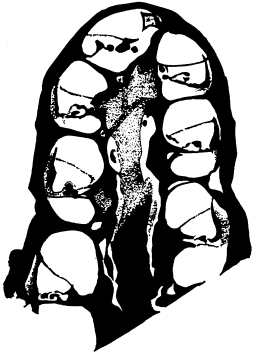
Cross-section of the cochlea of a guinea-pig (from De Burlet)

The form of vibration of the basilar membrane. For simplification the spiral of the cochlea has been drawn out straight (after v. Békésy)
As the sounds of the external world enter, whole vortex trains pass through the fluid of the inner ear. In connection with this a sorting out of rhythms takes place, by which the long wave trains of the low frequency low notes reach the end of the basilar membrane, while the short, quick rhythms of the high notes fade away right at the start. On a minute scale and as an organic function, this is the counterpart to the great sorting out process of the different types of wave in the oceans of the earth. (See the chapter: The Wave.) In the ocean, too, the different wave lengths are sorted out; the larger ones overtake the smaller ones and after long journeys reach distant coasts, while the smaller waves have ‘faded away’ after a short distance. The sorting out that takes place in the inner ear can thus be compared to an analysis, a splitting up into the constituent components, followed, however, by a synthesis, in which the human being reassembles what has been separated, piecing the sound image together again in a body of sound. This process is analogous to that of metabolism, where all food is at first broken down before being built up again and integrated into the organism in a composition fitting to the nature of each human being. This is a creative activity in the realm of number ratios, on the one hand in the realm of sound or music, on the other in the process of breaking down and building up of substances, where whole-number proportions prevail. Processes of hearing echo on in the processes of metabolism. In analogy with the metabolism of substances, one might call the process of hearing a metabolism of sound, in which the sounds taken in are broken down and then built up again according to the musical number ratios inherent in them.

Distribution of sensitivity to notes in the cochlea: high notes are localized near the stapes, and low notes near the apex of the cochlea
The rhythmical play of the fluid element in waves and vortices at the sensitive boundary surfaces has been brought together with the interpenetration of rhythms, thus becoming a sense-organ in the processes of the inner ear. Withdrawn from observation, they reveal the inner nature of processes expressed in the experience of sound, welling up in the soul life of the human being, in whom the processes we have been describing find their equivalent at a higher and more real level of existence. Indeed, the human body is built with the help of these processes, for it is permeated through and through with musical rhythms and numerical proportions. The great secret hidden in flowing liquids is that the harmony of the spheres resounds and vibrates within them. In the ear they have become sense organ! Flowing liquids provide an opening through which we can listen to the reflected splendour of the harmony of the spheres.
The Intestine
In the organ of hearing the three principles—spiralling surface, sensitive membrane and rhythmical activity—unite in the field of sensitivity and create a most delicate organ, finely formed and chiselled in every detail. We find these same principles again, of course, in the intestine. Now, however, according to the intestine’s own function they are to a great extent withdrawn from the sphere of form and manifest in the plasticity of movement. The capacity to perceive consciously is lost in the dark realm of metabolic activity. The whole formation of the intestines is directed towards the breaking down, liquefaction, destruction, permeation and transport of matter. And as in the process the matter becomes liquid, it may be supposed from the start that the paths along which it moves will correspond to the archetypal movements of the liquid element. Just as we see naturally flowing water moving in meanders, curves and spiralling loops, rhythmically creating its own river bed, so now we recognize these processes in digestion.

The digestive tract is rhythmically articulated in expansion and contraction (diagram after Rauber-Kopsch)
The spiralling surface is the guiding principle, but the forms are not greatly differentiated; rather is the formative force to some extent withdrawn in favour of movement and the dissolution of form.
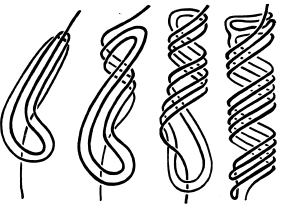
Development of the intestine of cryptoplax oculatus (from Ludwig)
The digestive tract as a whole, starting at the lips, is not simply a cylindrical tube, but a rhythmically articulated structure dividing the process of metabolism in space and time into several main parts, in expansion and contraction. It is as though this rhythm has become a form, and superimposed on it is the peristalsis of the intestine which is still purely movement.
The inner ear does not enter into any material relationship with what it perceives, but only into a rhythmical movement relationship which originates in the matter. The reverse is the case with the intestine. Matter fills out the organ, is broken down and disintegrated within it and at the same time set in most intensive and varied motion, surrendering itself entirely to the process. In the realm of sound the material world merely communicates its inmost being.
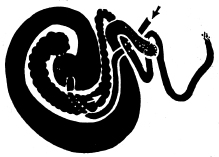
Intestine and appendix of the rabbit (after Zietschmann)
The varied movement of the liquefied matter along the intestine, in curving surfaces meanders and spiralling streams, can be studied in the animal world in great variety. A few illustrations will serve here.
The drawing 18 – in Circulating Systems and Spiralling Surfaces shows the intestine of a lungfish; a fully formed spiral fold imprints a corresponding movement on matter. Cryptoplax oculatus manifests this movement by twisting the intestine itself into screw-like formations. The large intestine of some animals, for instance the rabbit, shows a distinctly formed spiral that reappears in the appendix as a counter spiral. In the pig, the large intestine in particular is formed in several spiralling twists. Cattle, fundamentally creatures of digestion, have in their intestines a curling and uncurling spiral much like that of the ear.
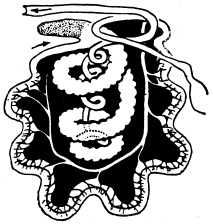
Intestinal convolutions of the pig (after Zietschmann)
What in the human being appears only as the indication of a spiralling fold at the very end of the intestine, is found in cattle as the shape of the organ as a whole; the liquefied stream of food substances moves through the intestine in accordance with the typical movement of flowing liquid. This formation in human beings is more restrained; they do not become creatures of digestion, but reserve their forces for spiritual activity.
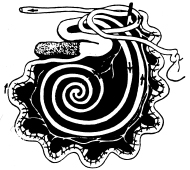
The spiral convolutions in the intestines of cattle are formed to perfection (after Zietschmann)
Calling to mind that the movements of a fluid vortex imitate a planetary system in miniature, and seeing that a similar movement is imprinted upon the liquefied food, for instance in the intestines of cattle, we have a picture of substance being taken from a planetary periphery to a sunlike centre and then spread out again into the periphery, while at the same time it is being thoroughly broken down and transmuted. It is a process which, if we consider the numerical relationships to be found in its rhythms, is akin to the world of sound.1
The Heart
Ear and intestine are polarities inasmuch as the organ of hearing belongs to the nerve-sense organization and the organ of digestion to the metabolic processes that take place in the unconscious. The heart lies spatially and also functionally between the two. It is as though the two ‘streams’, one from above, the other from below, meet in the heart and are balanced there in a primal rhythm.
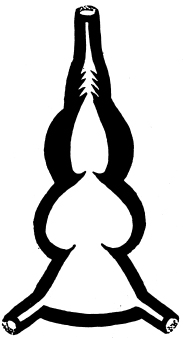
Diagram of the heart, early stage in fish, (after Nierstrasz)
Even a simple diagram of the heart reveals the movement on which it is based. The pattern resembles that made when a stream of liquid flows into still water, or when streams of liquid meet under water, where a rhythmic sequence of fluid regions is created, alternately accepting and rejecting space (Plate 47). The whole function and form of the heart is a reflection of the streaming processes of water, where in its movements of expansion and contraction it is as though separate spaces were continually being created. The hearts of some lower animals show a cavity formation similar to that in water. A long series of identical chambers is formed, in which the blood has to contract and expand as it flows through. In these hearts a wall surrounds what in the water is simply a pulsating stream; it serves to make the process more clearly visible. The organ pulsates in the rhythm of the stream of liquid out of which it has been shaped, thus simply making this rhythm visible.

The heart of the cockchafer, a rhythmical sequence of chambers (after Schmeil)
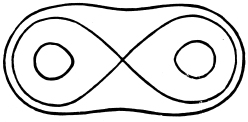
Solid particles are deposited in curves of Cassini in the field of currents arising around two uniformly pulsating chambers
In an experiment, two elastic vessels may be placed in water and caused to pulsate uniformly, like the chambers of the heart; currents will arise between them. If solid particles are added to the water they arrange themselves around the vessels in ridges perpendicular to the current. The ridges lie round the pulsating chambers in curves of Cassini like the corresponding muscle fibres around the pulsating heart chambers. It must not be forgotten that the very pulsating motion itself belongs to the nature of flowing liquid. Taking our start from facts like these, there is no need to imagine the activity of the heart to be that of a pump.
In the human heart, form and movement are interrelated, uniting space and time in a rhythmical process. The organ, a form in space, is simultaneously a movement in time.
This organ is like a vortical centre of suction to which the blood rushes with ever increasing speed from the periphery, thither to return again, slowing down and spreading out. It is an image of a planetary system with a sunlike centre of infinite dynamic force. The speed in the centre of a vortex tends to become inconceivably great; but infinite speeds are not possible on earth, hence the suction.
A vortex often pulsates in itself. Keeping a strict rhythm, it widens, growing shorter, and then contracts, growing longer. The archetypal movements of successive rhythms, which in the heart result in the formation of the separate chambers, interpenetrate with the pulses of individual local vortices.
The fibres of the heart are a physical echo of the creative movements by which it was begotten. In spiralling paths they swing down to its apex and then rise again to its base. They make the same movements and emphasize the revolving vortical streaming of the fluids within the heart.
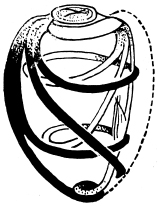
Fibres in the left chamber of the human heart (after Benninghoff)
In the lungfish a spiral fold is even built into the centre of the blood stream, dividing the lumen into two halves, in which the two kinds of blood flow separately. An observer thinking only of utility will see in this merely a division between the two kinds of blood. But if we think of the inner dynamic quality of the process itself we see that even without such a fold the blood stream will remain divided into two parts, contiguous in a surface. It is as though this surface were to suck the living material to itself and appear as a visible fold. According to how an elastic tube is bent, the surface of contact between the two secondary streams is twisted within it.
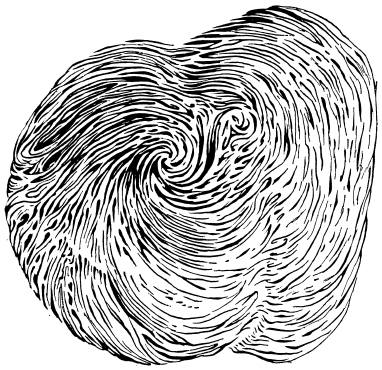
Spiralling fibres at the apex of the heart (after Benninghoff)
The heart, then, a rhythmical organ, is formed from the intertwining, spiralling fibres and surfaces which consolidate out of the pulsating, flowing movement. The movement itself is not altered; rather do the surfaces grow into what has already been invisibly pre-formed.
Besides the rhythmical activity we may also expect to find the quality of sensitivity in the blood stream of the heart. An examination of the formation of the nervous system of the heart will show that even in simply constructed hearts the sensitive places are to be found precisely at those points where we would expect to find sensitive places in a stream of liquid. These places occur wherever the stream contracts and has to pass through a narrow space, creating as it does a moving layer of surfaces.1 Here too it is as though an organ, at first concealed in the flowing stream of blood, becomes consolidated into a finished form. Various receptive centres, points sensitive to the different qualities of the blood stream and its composition, may be found in the heart. It is permeated through and through with a delicate capacity of perception through which it takes account of the messages brought to it from the organism by the blood. It is like the sun centre of the organism itself, which ‘hears and speaks’ in order to co-ordinate the whole organism with its inner reciprocal relationships in the living rhythms of time. No wonder it is connected via the rhythm of breathing with the rhythms of the cosmic sun year, which for its part co-ordinates the systems of planetary movement to form an organism.
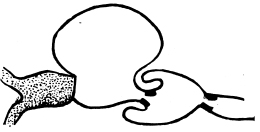
The centres of automatic action in the heart of a fish are situated at the ‘sensitive’ points in the stream where it narrows (from Buddenbrock, after v. Skramlik)
It is not our purpose here to consider in all detail the anatomical structure and physiology of various organs. We are concerned to indicate a way of understanding the creation of organic forms and above all to show how flowing water contains the archetypal images of the threefold nature of man with all his organs. Accordingly blood, itself a liquid and therefore still unformed, bears these archetypal images within it and materializes them anew at every moment, out of its streaming movement. The blood is indeed the archetypal organ of liquid flow. As a liquid it has all organic formation potentially within it. As ‘blood’ it is the expression of the spiritual being according to whose idea the various organs are moulded and assembled to form a total organism—the body in which this being may live.
If therefore blood is an expression of the being ruling over it, may we not ask if there is a similar higher being of whom water, the ‘blood of the earth’, is the physical expression?
1 See the basic explanations in Steiner Von Seelensätseln.
1 L. J. Henderson’s basic work The Fitness of the Environment gives information on the important processes of osmosis and diffusion within the living cell.
1 In spiritual science we learn of the activity of the chemical- or sound-ether in connection with number ratios in the realm of sound and in chemical processes. The chemical-ether permeates in particular the world of the watery element, and, as bearer of sound, the region of the air also.
1 We shall show later how defiles like this are always places of heightened sensitivity.